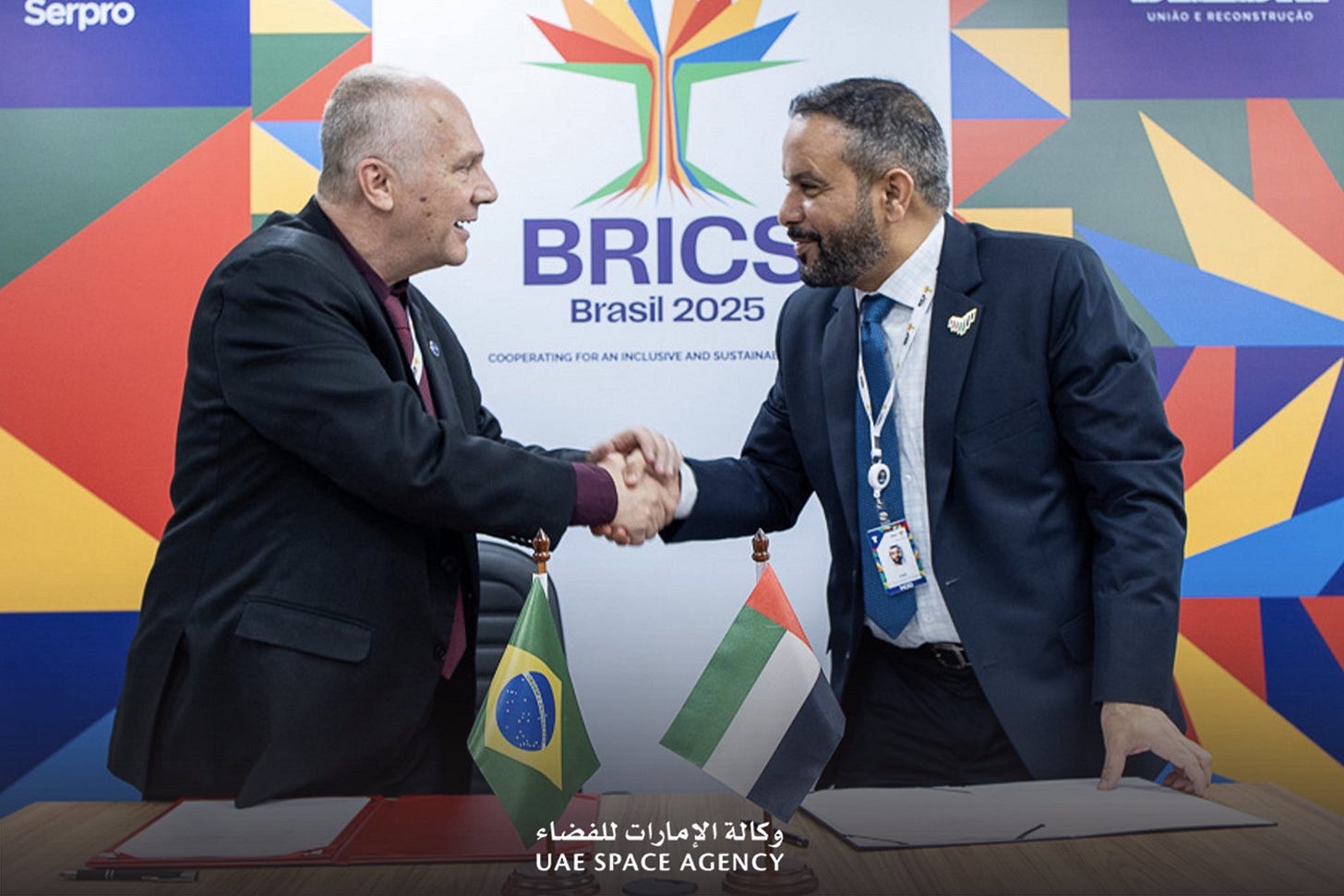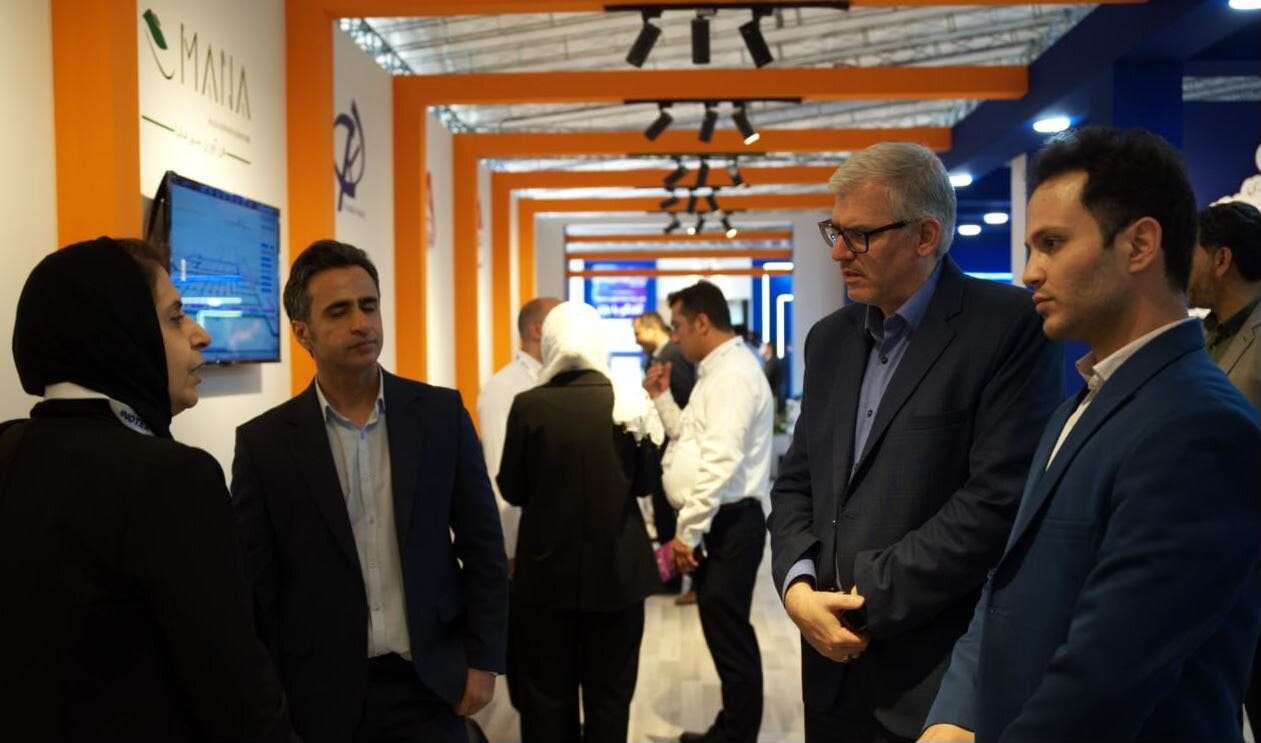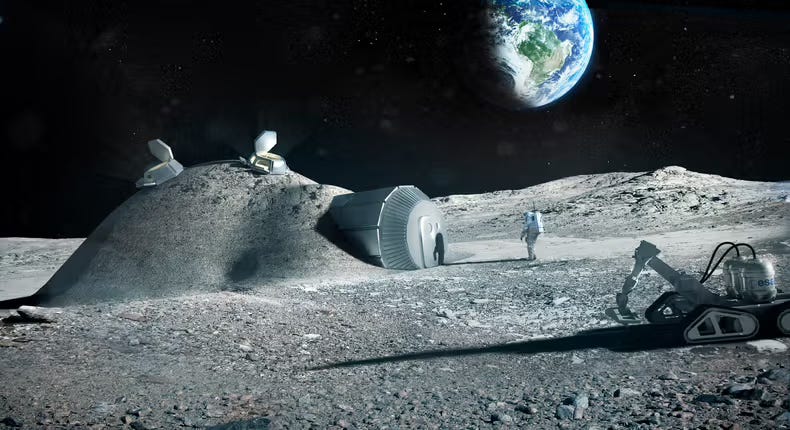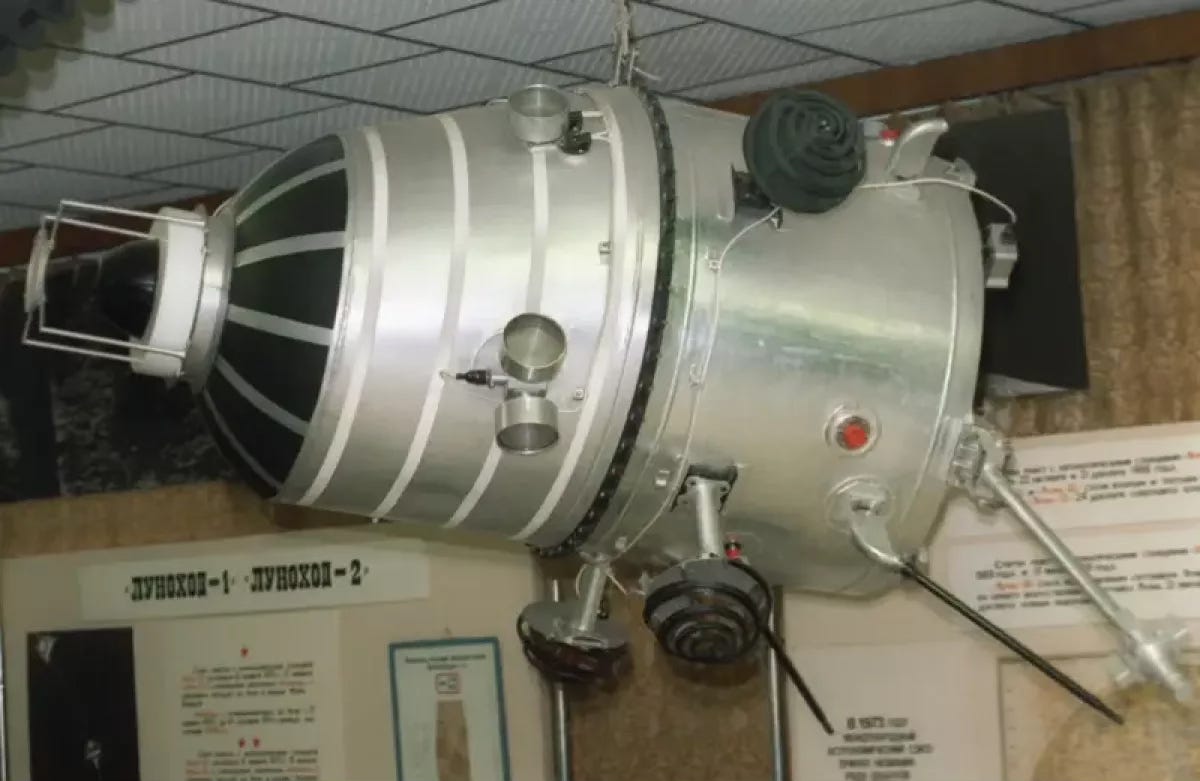Middle East Space Roundup: 28 April to 4 May 2025
A summary of all the space news in the Greater Middle East over the past week, brought to you by AzurX

The following are the major space developments in the Greater Middle East region tracked by Middle East Space Monitor over the past week:
UAE Space Developments
UAE Participates in BRICS Space Summit in Brazil, Signs MoU With Brazilian Space Agency
At the BRICS Heads of Space Agencies meeting in Brazil, the UAE Space Agency and the Brazilian Space Agency signed a Memorandum of Understanding to advance bilateral cooperation through the exchange of satellite imagery and geospatial data across key sectors such as water management, disaster monitoring, environmental assessment, and resource exploration. The agreement underscores a shared commitment to leveraging space technologies for sustainable development and socioeconomic impact, aligning with the UN Sustainable Development Goals. UAE Space Agency Director-General Salem Butti Al Qubaisi emphasized the strategic value of international collaboration and data sharing to drive innovation and global scientific progress at the meeting.

UAE’s Lunar Gateway Airlock At Risk With Proposed 2026 NASA Budget
The Trump administration’s proposed 25% cut to NASA’s budget—reducing it from $25 billion to $18.8 billion—targets major programs such as the Lunar Gateway, an international initiative supported by the UAE, Europe, Japan, and Canada to establish a lunar-orbiting station by 2027. The proposal calls Gateway “unaffordable” and recommends phasing out the Space Launch System (SLS) and Orion capsule after only three missions, signaling a shift away from traditional public-sector-led exploration. Despite these cuts, the administration claims to prioritize beating China back to the Moon and advancing toward Mars, allocating $7 billion to lunar efforts and $1 billion to Mars-focused programs—likely betting on private sector solutions through firms like SpaceX and Blue Origin. If enacted, the withdrawal of U.S. support would significantly undermine Gateway and diminish international collaboration prospects, including the UAE’s planned contribution of a crew airlock module.
UAE Delegation in Finland Visits SAR Satellite Manufacturer ICEYE
A high-level UAE delegation led by Omran Sharaf, Assistant Foreign Minister for Advanced Science and Technology, concluded a strategic mission to Finland aimed at deepening bilateral cooperation in advanced technologies, with a strong emphasis on space, quantum computing, and AI. The delegation engaged with Finnish counterparts across key institutions, including VTT, ICEYE, and IQM Quantum Computers, highlighting shared interests in space-based innovation and emerging technologies. Notably, ICEYE—known for its commercial synthetic aperture radar (SAR) satellite capabilities—underscored potential avenues for UAE-Finland collaboration in Earth observation and space data applications. The visit signals the UAE’s intent to expand its global technology partnerships and further integrate into advanced R&D ecosystems, reinforcing its long-term positioning in critical technology domains.
UAE Pavilion at Expo 2025 in Japan Showcases Emirati Space Achievements and Ambitions
At Expo 2025 Osaka-Kansai in Japan, the UAE Pavilion’s Explorers of Space platform showcases the UAE’s evolving space ambitions, from the Emirates Mars Mission to upcoming satellite constellations, underscoring a strategic blend of heritage and high technology. Central to this effort is Space42, the UAE’s leading AI-integrated space technology firm, whose sponsorship and content curation spotlight its global operations across 150+ countries and its expanding portfolio of smart connectivity and Earth observation satellites. Flagship initiatives such as the Thuraya-4 communications satellite, the Foresight constellation, and the Al Yah 4/5 satellites illustrate the UAE's dual commitment to sovereign capability and international collaboration. The pavilion’s theme, From Earth to Ether, reinforces the narrative of national identity driving innovation, symbolized by a palm-frond rocket sculpture crafted by Emirati artisans—a fusion of cultural legacy and future-forward space aspirations.
UAE’s DEWA Leads Way in Satellite Applications for Utilities With Space-D Program
Dubai Electricity and Water Authority’s (DEWA) Space-D program, launched in 2021, is rapidly emerging as a model for integrating space technologies into critical infrastructure management. Through the successful deployment of two Emirati-built nanosatellites—DEWA SAT-1 and SAT-2—the initiative leverages IoT, AI, and Earth observation to enhance operational efficiency across Dubai’s electricity and water networks. Applications include substation monitoring, transformer diagnostics, solar plant optimization, desalination protection, and smart grid visibility, all powered by satellite-derived data and custom IoT terminals. Anchored at the Mohammed bin Rashid Al Maktoum Solar Park, Space-D positions the UAE’s DEWA at the frontier of utility-focused space innovation, training national talent and building sovereign satellite capabilities for real-time infrastructure intelligence and predictive maintenance.
UAE Space Agency, Space42, Launch Second Cohort Space Training Program
The UAE Space Agency has launched registration for the second cohort of its flagship Earth Observation training program under the National Space Academy, in strategic partnership with AI-driven space technology firm Space42. Running from May to July 2025, the program targets Emirati professionals and researchers in STEM, remote sensing, and AI, reinforcing national capacity in space applications. With a focus on applied skills and sovereign capability development, the initiative aligns with the UAE’s Space Strategy 2030 and its broader vision to foster a knowledge-based economy. Notably, 70% of last year’s graduates secured roles in the space sector, underscoring the program’s role as a talent pipeline for national space leadership.
Oman Space News
Oman’s Etlaq Spaceport Opens Doors to Public With Educational Fan Zone
Oman's Etlaq Spaceport marked a regional first by opening its doors to the public through a three-day educational fan zone aimed at inspiring youth engagement in space. Despite the weather-delayed launch of the UK-developed Horus-4 experimental rocket, the event underscored Etlaq’s dual role as a launch site and public outreach platform. Backed by growing public and private investment, the initiative signals Oman’s strategic commitment to nurturing a domestic space ecosystem, combining early STEM education, international partnerships, and reusable rocket demonstrations to position the country as a testbed for commercial launch activity in the Middle East.
Oman’s Etlaq Spaceport Expects Orbital Launch Complex to be Completed by 2027
Oman’s Etlaq Spaceport is emerging as a strategic regional hub for rapid, low-friction rocket launches, offering private space start-ups accelerated mission timelines through its Genesis program—an interim test-launch facility in Duqm that enables high-altitude missions within 13 weeks. As global launch providers face protracted regulatory delays, Etlaq’s streamlined approach, established regulatory framework, and readiness for small test flights—like the upcoming Horus-4 reusable rocket—position it as a compelling alternative, especially for Middle East and African markets. Construction of the full-scale orbital spaceport, set to open in 2027 with capabilities for small to heavy-lift vehicles, is on track. Meanwhile, Etlaq is investing in community engagement and workforce development through initiatives like Etlaq FX, reinforcing its long-term role in the global launch ecosystem.
Egypt Space Developments
Egypt Poised to Join International Lunar Research Station Consortium
At the recent BRICS space agency summit in Brazil, Egypt emerged as a potential partner in the ambitious Russian-Chinese International Lunar Research Station (ILRS), slated for completion by 2035 and now revealed to include plans for a lunar nuclear reactor. Egypt is reportedly among five African countries in discussions to join the 13-member ILRS consortium, signaling Cairo’s growing alignment with alternative space coalitions beyond traditional Western partnerships. Participation would mark a significant step for Egypt’s space ambitions, positioning it within a major Sino-Russian initiative aimed at permanent lunar presence and off-Earth infrastructure. Egypt also features in China’s broader Africa2Moon collaboration, which targets lunar radio astronomy through low-cost lunar antenna arrays. These developments underscore Egypt’s expanding role in emerging multipolar space architectures, particularly those integrating African space capabilities into long-term lunar and orbital infrastructure plans.
Egypt Participates in Brazil’s BRICS Space Agency Summit
The Egyptian Space Agency’s CEO participated in a high-level BRICS space meeting in Brazil, marking Egypt’s growing role in the bloc following its accession in January 2024. The agenda focused on advancing a BRICS-led satellite constellation initiative to support the UN’s 2025 climate goals, hosted by Brazil at COP30, and on narrowing technological disparities between member agencies. Discussions also emphasized capacity-building and human capital development, reinforcing the bloc’s commitment to space-based sustainable development. The meeting reflects BRICS' strategic alignment in using space cooperation to address global challenges and strengthen South-South technological integration.
Iran Space News

Iran’s Public-Private Partnerships Has 20 Satellites in Its Pipeline
Iran is advancing a new space development model centered on public-private partnerships, with around 20 satellites—led by the Shahid Soleimani constellation—currently in production through state-backed consortia involving private firms. Speaking at the 2025 INOTEX Exhibition, Iranian Space Agency chief Hassan Salarieh emphasized the growing leadership role of the private sector in satellite manufacturing and operations, supported by a government-guaranteed satellite imagery procurement program. This strategic pivot reflects Iran’s push to accelerate remote sensing capabilities, foster a space-based economy, and remain competitive globally. The move also aligns with Iran’s broader innovation agenda, as showcased at INOTEX, where space and AI-based solutions featured prominently among over 500 participating startups and firms.
Iran’s Chabahar to Become Country’s Most Capable Spaceport
Iran’s space program is expanding steadily despite intensified U.S. sanctions, with the Iranian Space Agency (ISA) advancing public-private satellite development and preparing to open the country’s third and most capable launch site near Chabahar. The new spaceport—poised to become Iran’s central hub—will support heavier rockets like the Simorgh, which recently delivered the country’s largest payload to date. While Iran insists its activities are for peaceful purposes, the dual-use nature of its space infrastructure, including satellite constellations and launch vehicles, has drawn scrutiny from the U.S., which sees clear ICBM potential. Iran is increasingly relying on technical support from Russia and is actively cultivating domestic private-sector capabilities in satellite manufacturing and data services, reflecting a strategic shift to sustain and scale its space ambitions under economic and geopolitical pressure.
Iran Inaugurates Weather Satellite Data Reception Station With Support from APSCO
Amid rising environmental stress from frequent dust storms and expanding drought, Iran has inaugurated its first satellite data reception station dedicated to environmental monitoring and disaster forecasting. Located at the Mahdasht Space Base and launched in collaboration with the Asia-Pacific Space Cooperation Organization (APSCO), the facility receives geostationary satellite imagery every 30 minutes to track severe weather, atmospheric conditions, and climate patterns. This capability marks a significant enhancement in Iran’s space-based environmental surveillance, enabling more accurate forecasting and resource management at a time of intensifying climate-related challenges.
Saudi Arabia Space Developments
Orbital Universe Startup Selected by Saudi Arabia’s DISAI Accelerator Program
Saudi Arabia’s inaugural “Design in Saudi Arabia with AI” (DISAI) accelerator—launched by Qualcomm, Aramco, and the RDIA—highlights the Kingdom’s strategic push into frontier technologies, with clear implications for the space and satellite sector. Among the six selected startups, Orbital Universe stands out for its use of space imaging and IoT sensors to monitor carbon sequestration in mangrove ecosystems, showcasing how Earth observation data can support national sustainability goals. The program reflects growing regional ambition to integrate space-based data with AI, edge computing, and 5G infrastructure, aligning with Saudi Vision 2030’s emphasis on digital and industrial innovation. With Qualcomm’s technical mentorship and Aramco’s sectoral experience, DISAI positions the Kingdom as an emerging hub for space-adjacent AI applications with commercial scalability and environmental impact.
Opinion: Saudi Arabia’s Neo Space Group Redefining Inflight Connectivity
In SpaceWatch.Global, Yvette Gonzales writes that as global flight capacity rebounds, Saudi Arabia’s Neo Space Group (NSG), a Public Investment Fund (PIF) company, is redefining the in-flight experience through its advanced satellite-powered connectivity platform, Skywaves®. With air travel reaching over 118 million passengers weekly and in-flight hours surging, NSG is capitalizing on this captive market by integrating multi-orbit satellite networks (via SES), cutting-edge antenna systems, and AI-driven personalization to deliver seamless broadband, entertainment, and e-commerce at altitude. NSG’s In-Flight Connectivity (IFC) system—enhanced through partnerships with Display Interactive and Thai Airways—blends sustainability, accessibility, and cloud-based innovation to expand passenger services and reduce airlines’ environmental footprint. Positioned as a key driver of Saudi Vision 2030, NSG is leveraging space-based infrastructure to transform aviation connectivity, targeting global leadership in satellite communications and setting a new benchmark for airline service quality and operational resilience.
Azerbaijan Space News
Failed Soviet Spacecraft Could Impact Azerbaijan, Türkiye, Syria, and Egypt
Kosmos 482, a failed Soviet Venus mission launched in 1972, is projected to reenter Earth's atmosphere between 8 and 14 May 2025, with a potential impact zone spanning Azerbaijan, Türkiye, Syria, and Egypt. Weighing nearly 500 kg and built to endure Venusian conditions, the descent module may survive reentry and reach the surface with limited explosive force. While the risk to populated areas is minimal, regional authorities—particularly Azerbaijan, with its advanced satellite infrastructure and growing role as a space technology hub—are closely monitoring the situation. The incident underscores the enduring legacy of Cold War-era space debris and the critical role of regional space agencies in orbital risk management.
Azerbaijan’s Azercosmos Generated $4 Million in Revenue in Q1 2025
Azerbaijan’s Azercosmos generated $4 million in satellite telecommunications service exports during Q1 2025, accounting for 65% of its total revenue and reaching nearly 100 companies across 40 countries. While the agency remains a key regional space services exporter, the figures reflect a 14.9% year-on-year decline, with March exports down 23.5% and a reduced geographic footprint. The UK and Luxembourg led the customer base, followed by Nigeria, Egypt, and Pakistan. The data suggests a need for strategic diversification and competitiveness as market dynamics and global demand for satellite services evolve.
Other Regional Space Developments

Türkiye and Italy Sign Space Cooperation Agreement
At the 4th Türkiye–Italy Intergovernmental Summit in Rome, President Erdogan advanced Türkiye’s strategic positioning as a regional gateway and emphasized bilateral cooperation in high-tech sectors, notably space. Among the 11 memorandums signed, a key agreement between the Turkish Space Agency and the Italian Space Agency formalized collaboration in peaceful space exploration—signaling deeper alignment in satellite development, research, and space policy coordination. This partnership underscores Türkiye’s ambition to elevate its space program through strategic European ties, while the broader summit agreements—spanning defense, infrastructure, and science—reflect a coordinated push to integrate space into a wider industrial and geopolitical agenda.
Yemen’s Houthis Order the Surrender of All Starlink Satellite Internet Terminals
In a move underscoring both strategic control and geopolitical anxiety, Houthi authorities in Yemen have ordered the immediate surrender of all Starlink satellite internet terminals, citing national security concerns and sovereignty violations. The Ministry of Communications in Sanaa warned of punitive measures for non-compliance, including coordinated enforcement with security forces. While Starlink’s entry into Yemen last September was hailed by users desperate to bypass unreliable and heavily surveilled networks, the Houthis view the service—endorsed by Elon Musk and widely adopted despite the conflict—as a U.S.-backed intrusion. The episode highlights the contested terrain of digital infrastructure in conflict zones, where connectivity itself becomes a battleground.
Tunisia’s AGEOS Signs MoU With SatNav Africa for GNSS & SBAS Development in Africa
At the 2025 NewSpace Africa Conference in Cairo, Egypt, the SatNav Africa Joint Programme Office (JPO) and Tunisia’s African Association for Geospatial Development (AGEOS) signed an MoU to advance GNSS and SBAS development across Africa. The agreement establishes a cooperative framework focused on fostering innovation, building local capacity, and supporting business clusters in satellite navigation and geospatial applications—key enablers of the African Space Policy and Strategy. The partnership also aligns with the broader Africa-EU Space Partnership Program and prioritizes youth and women’s empowerment, marking a strategic step toward expanding Africa’s autonomous capabilities in satellite-based technologies critical to civil aviation, economic integration, and sustainable development.
Qatar’s Es’hailSat in Talks With Iraqi Kurdistan’s Kurdistan24 for Satellite Broadcasts
A Qatari delegation led by Consul General Hussein bin Ali and representatives from leading satellite operator Es’hailSat visited Kurdistan24 in Erbil, Iraq, to explore strategic media cooperation and satellite broadcasting collaboration. The visit underscores Es’hailSat’s role as a key regional enabler of satellite TV transmission and signals Kurdistan24’s rising prominence as a regional broadcaster. As media ecosystems across the Middle East undergo rapid transformation, this engagement reflects Qatar’s growing interest in Kurdistan’s communication infrastructure and highlights opportunities for cross-border content exchange, technological development, and expanded satellite distribution networks.
Armenia’s Hayasat-1 Completes Mission After Reentering Earth’s Atmosphere
Armenia’s first domestically developed satellite, Hayasat-1, completed its mission on 26 April 2025, after re-entering the atmosphere due to accelerated orbital decay driven by heightened solar activity. Developed by Bazoomq and the Center for Scientific Innovation and Education (CSIE), and launched aboard a SpaceX Falcon 9 in December 2023, the mission marked a milestone in Armenia’s space ambitions. Despite a shortened operational lifespan, Hayasat-1 provided critical data and experience, laying the groundwork for more advanced national space initiatives and reinforcing the country’s entry into the growing community of sovereign satellite operators.
Other Regional Space News in Brief:
Rivada Space Networks has appointed Mustafa Afifi as Sales Director for the Middle East to bring the Rivada Outernet LEO SATCOM solution to the region.
Be sure to catch up with space activities in the region in the next edition of Middle East Space Monitor’s space roundup!











